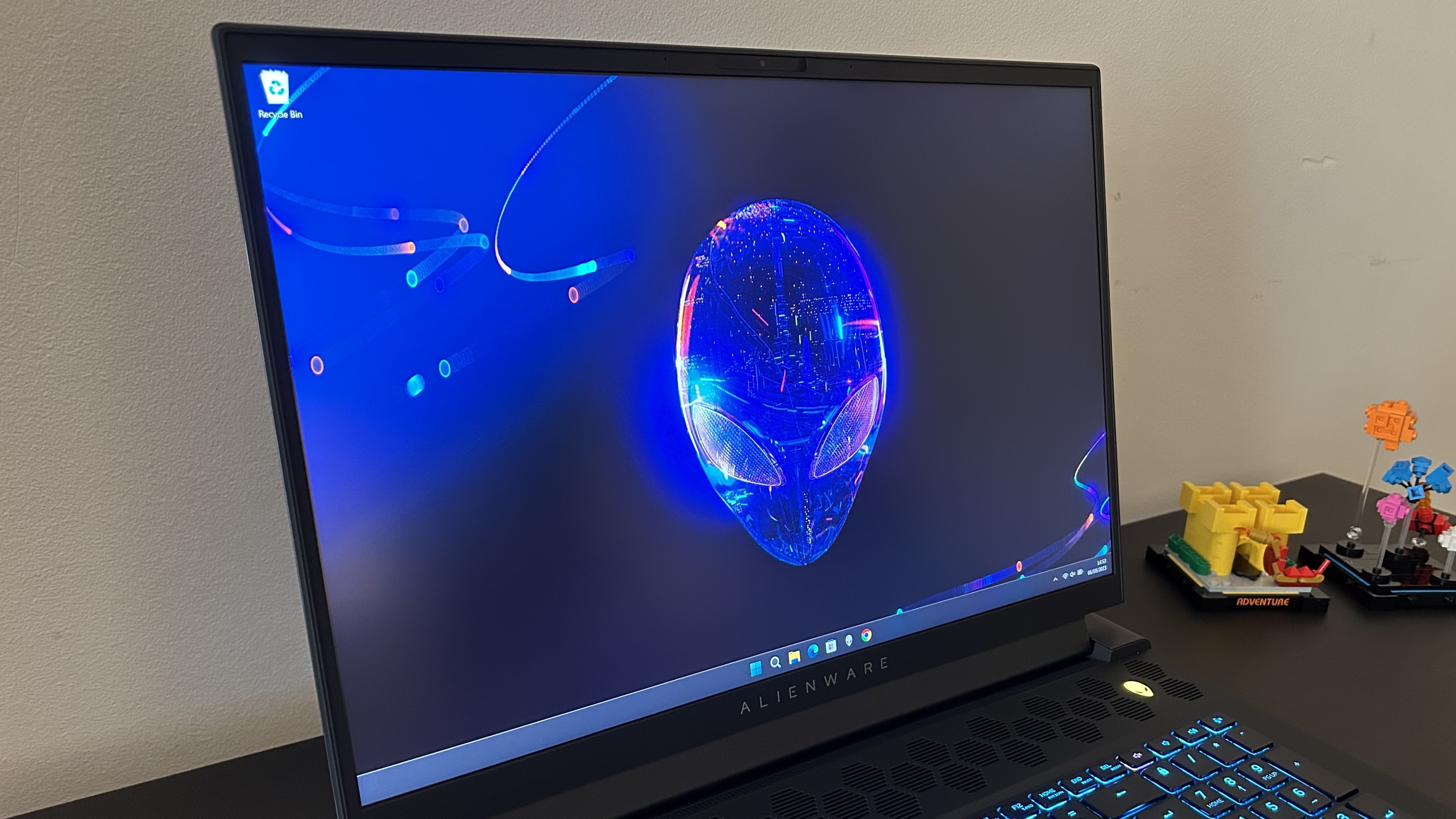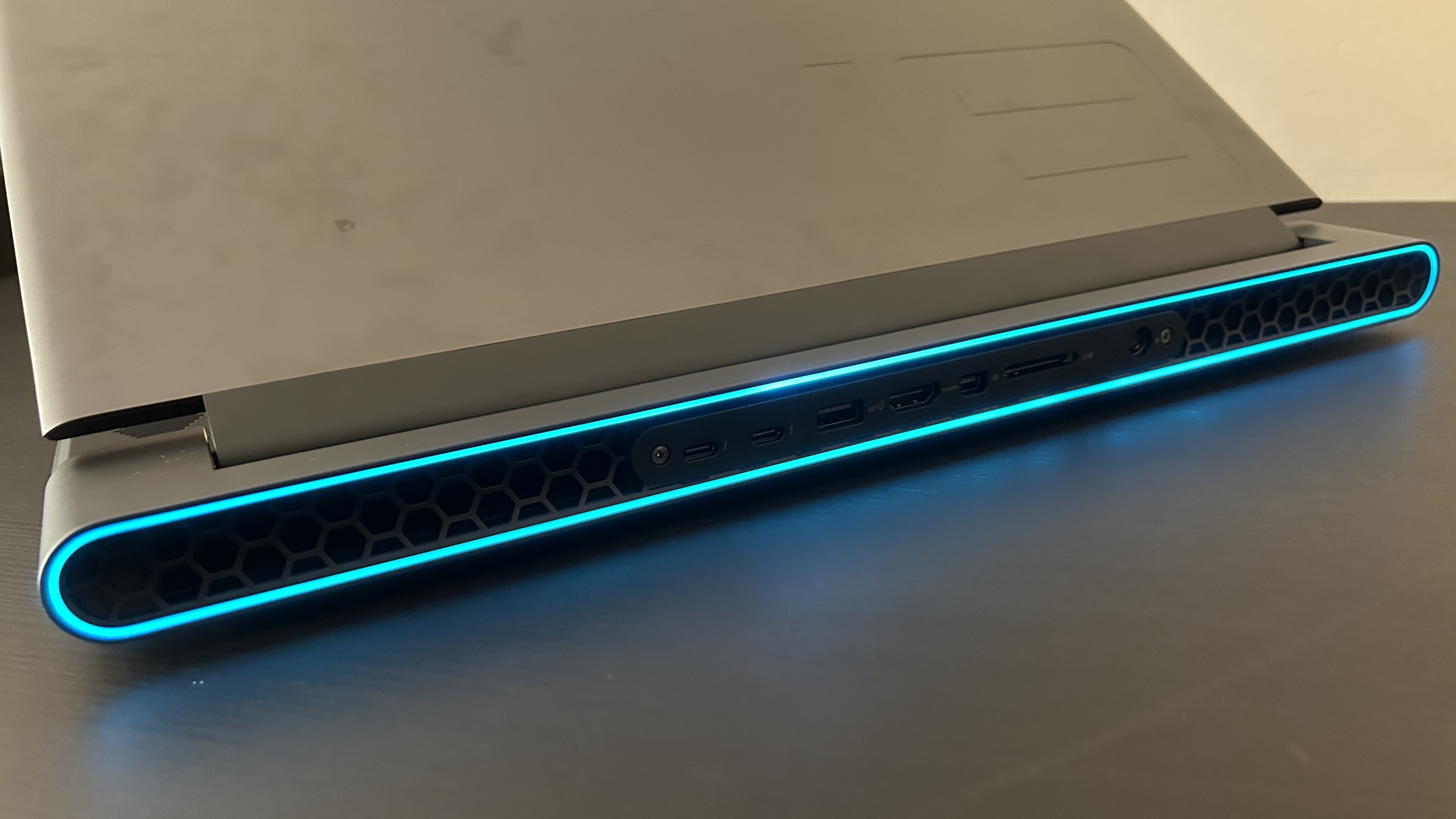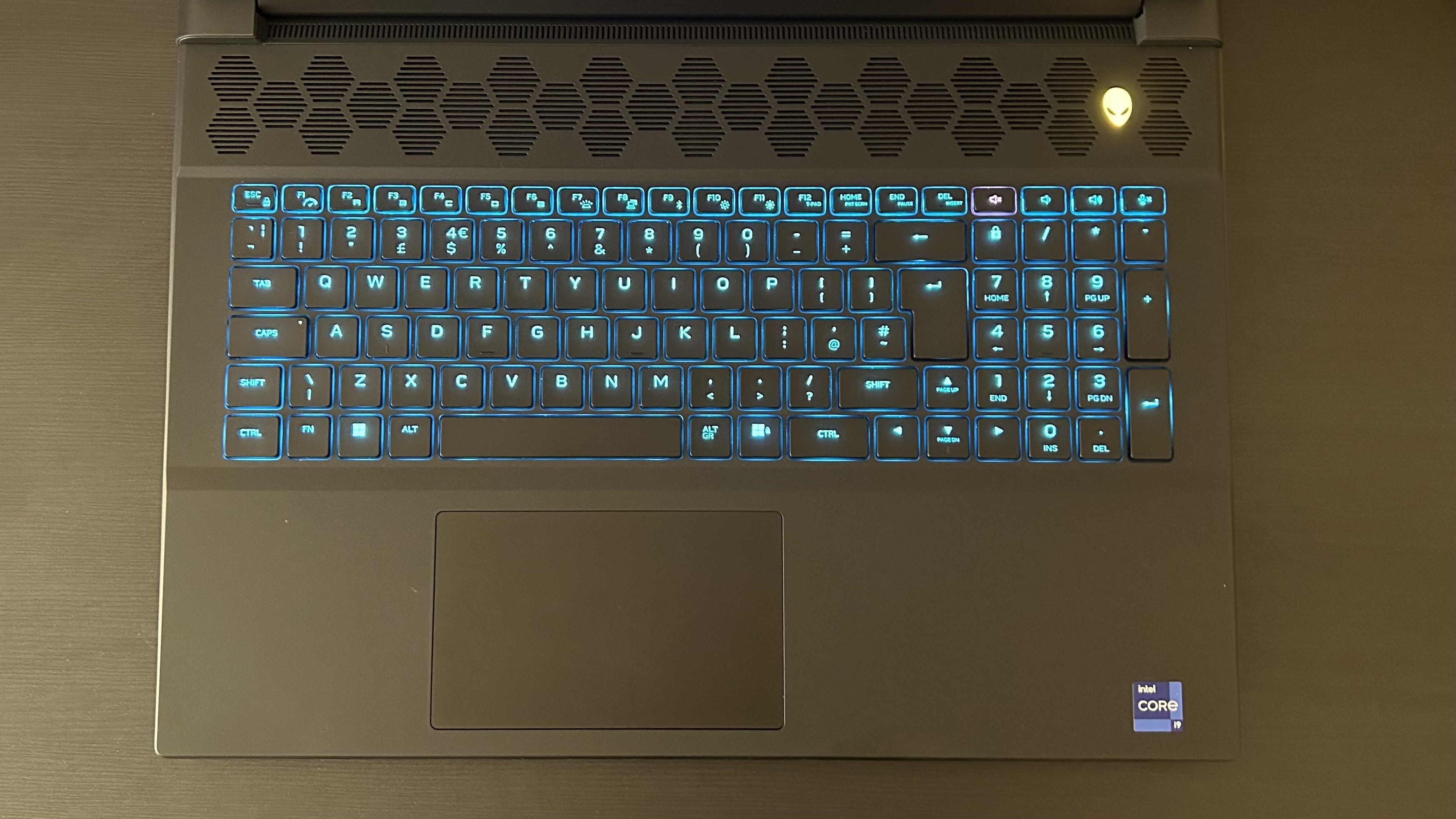GamesRadar+ Verdict
The Alienware M18 is a powerhouse of a gaming laptop, combining a smart design with plenty of grunt under the hood for a serious desktop replacement. While the speakers and display can't quite keep up with other options, the range of configurations available make it a go-to for anyone who doesn't want to blow past $3,000.
Pros
- +
Incredible power under the hood
- +
Cheaper configurations than Razer or Asus
- +
Subtle design
- +
Plenty of ports with excellent placement
- +
Full sized keyboard and number pad
Cons
- -
The heaviest gaming laptop we've tested so far
- -
Display quality doesn't live up to competition
- -
Speakers don't feel as robust as Scar 18
Why you can trust GamesRadar+
The Alienware M18 is an absolute unit. Yes, we know 18-inch gaming laptops are giving us sky high performance numbers in 2023, but Dell's first big-screen machine can not only top those charts but also squeeze itself down into far more stomachable price points. That's not something we can say for the majority of the best gaming laptops - so whether you're after an RTX 4090 powerhouse or a steadier RTX 4060 rig, the M18 is bringing big-screen gaming to all.
Configurations start at $1,699.99 / £1,798.99, but our test unit came closer to $3,000. We say close to 3K because the configuration I tested doesn't seem to be a viable option on Dell's part picker right now. My Intel i9-13900HX CPU can't be paired with the RTX 4090 whirring away in this test rig anymore, but you'll find an i9-13980HX model available for $3,199.99 instead.
All that's to say, this is actually cheaper than the Asus ROG Strix Scar 18 and much cheaper than the Razer Blade 18 it's going up against. Considering the incredible performance I saw from in-game benchmarks and industry tests, that's no mean feat. Yes, Alienware has made some sacrifices along the way - in screen, speakers, and portability - but if you're after a desktop replacement that really can take over your setup, you're in the right place.
| Spec | Tested | Also Available |
|---|---|---|
| Price | $3,199.99 / £3,428.99 (i9-13980HX CPU) | $1,699.99 / £1,798.99 - $4,999.99 / £5,099 |
| Display | 18-inch QHD+ (2560 x 1600), 165Hz | 18-inch FHD+ (1920 x 1200), 480Hz |
| Processor | Intel i9-13900HX | Intel i7-13700HX | Intel i9-13980HX | AMD Ryzen 7 7745HX | AMD Ryzen 9 7845HX | AMD Ryzen 9 7945HX |
| GPU | Nvidia RTX 4090 | Nvidia RTX 4060 | RTX 4070 | RTX 4080 | AMD Radeon RX 7600M XT |
| RAM | 32GB DDR5 | 16GB DDR5 | 64GB DDR5 |
| Storage | 1TB SSD | 2TB SSD | 4TB SSD | 8TB SSD |
| Connectivity | WiFi 6E, Bluetooth 5.3 | - |
| Ports | 1x USB 3.2 Gen 1 (PowerShare), 2x USB 3.2 Gen 1, 1x USB 3.2 Gen 1 Type-C, 2x USB 3.2 Gen 2 Type-C (DisplayPort), 1x RJ45 Ethernet, 1x 3.5mm audio, 1x mini-Display, 1x HDMI 2.1 | - |
| Dimensions | 410 x 319 x 25 mm | - |
| Weight | 9.32lbs (4.23kg) | - |
Design
Despite its chunky weight, the Alienware M18 actually feels a little slimmer than the Asus ROG Strix Scar 18. It's by no means the sleek, almost-portable Razer Blade 18, but with a tapered edge to the front lip it's a lot less imposing on the desk top. Don't get me wrong, this still isn't a machine you'll be slinging in a backpack, but it feels more manageable thanks to this sloped design.

Elsewhere, everything is as you would expect from an Alienware laptop. The embossed 18 is the only aesthetic difference between this and the smaller Alienware M16 I had my hands on earlier in the year. You're still getting the cool gray sheen across both the aluminium lid and plastic main body, with hexagonal grills running underneath the main display. The RGB Alienware logo and slimline ring of light around the rear ports remain as well, adding an optional flair to an otherwise understated rig.
Everything feels solid here, with a build quality and material selection that feels worthy of that high-end price tag. This is though, without a doubt, the heaviest gaming laptop I've ever had to lug around. Just lifting the base slightly to check out the rubber feet underneath is a two-handed affair. That 4.23kg weight is far heavier than the 3.1kg shared by both the Scar and the Blade. While none of these laptops are going to be regular travel companions, the Alienware M18 is going to be even more difficult to transport should the need arise.
Features
The massive 18-inch display takes pride of place here, as it should. This is an all-immersive screen designed for those after a monitor replacement as well as a high-end PC. It can take a little getting used to - especially if you're more used to using a gaming laptop in 'lap' mode. However, it's a particularly enticing experience once you've had a taste of it, and works well across both gameplay and daily productivity multi-tasking.

The M18's display comes in two flavors, a higher resolution but ultimately slower QHD+ 165Hz panel, or a lower 1920x1200p resolution with a super quick 480Hz refresh rate. The latter is going to satisfy competitive gamers far better than it will those after a exciting solo adventures, so the majority of players will opt for the QHD+ option. That makes the 165Hz refresh rate a little disappointing - the Razer Blade 18 and Asus ROG Strix Scar 18 both pack 240Hz speeds into their QHD+ panels - with Asus going a step further and packaging HDR capabilities in as well.
On paper, then, the Alienware M18 falls behind in its display capabilities, but I was still impressed with the sharpness and detailing on this panel. Like other Alienware rigs I've tested, the matte covering across the screen leaves it struggling for brightness, and color contrast can sometimes suffer as well. Similarly, you'll find better motion handling from higher framerates in Razer and Asus's panels as well.
Where Alienware does have the upper hand, though, is in both its port selection and placement. There's a generous supply of inputs and outputs here, with the majority relegated to the rear of the device. That meant I was able to quickly set everything up and keep all those messy cables out of sight while using. I primarily tested the M18 by itself on a desk top, but also tested when connected to a monitor, keyboard, and mouse via an external dock. With ports on the back and a few easy access USBs on the sides, I had everything I needed without any clutter. That's exactly what you want from a laptop touting itself as a desktop replacement - unfortunately the Scar 18 and Blade 18 can't quite offer the same.

Of course, the magic happens under the hood - and if you're looking to spend a little less, this is where Alienware has Asus and Razer beat again. Not only can you configure the M18 to feature the latest and greatest components (an Intel i9-13980HX and RTX 4090), but Alienware has also included specs that take you all the way down to the mid-$1,000s. A baseline configuration comes in at just $1,699.99 / £1,798.99 - far cheaper than the options available on other 18-inch rigs. That's perfect for those after the big screen experience but don't need the full whack of an RTX 4080 or RTX 4090 GPU.
Supporting that massive screen is a set of decent speakers - while they're certainly loud, they lack the robust sound quality of the Strix Scar. Of course, with fan noise added to the equation, you'll likely be seeking out a gaming headset for full immersion, but if you're also going to be playing movies and music from these built in speakers, it's worth noting that they do come across a little lighter than other options.

The keyboard running along the mid section of the main deck is full sized with a generous number pad and plenty of dedicated function options and media controls. That's to be expected from an 18-inch gaming laptop, but not taken for granted - the Blade 18, for example, keeps things restricted to basic typing only.
Performance
Time Spy: 21,029
Fire Strike: 34,040
PC Mark 10: 7,704
Before getting my hands on the Alienware M18, the Asus ROG Strix Scar 18 was the most powerful gaming laptop I had tested. That still stands, but the M18 has come closest to knocking it off its podium. With blazingly fast benchmarks that beat the Scar in a couple of areas, though do lag slightly behind in the majority of tests, the M18 is an absolute powerhouse. I saw three figure framerates across all tests in the highest of graphics settings, which we've come to take for granted across 18-inch RTX 40-Series devices these days. However, even trickier ray tracing efforts were met with incredible power. DLSS 3 manages to push everything into a new dimension here, with the component power and cooling tech to keep it all running smoothly as well.
The M18 beat the Scar 18 in Time Spy score and in-game benchmarking across Returnal and Total War: Three Kingdoms, two more demanding titles that the Scar 18 couldn't quite keep up with. While you will get a more well-rounded power level with the Scar 18, then, there are some spikes to the M18's performance that keep it in the fight.
This is the kind of performance we expect from a machine making a bid to take over from a full desktop PC. You'll be paying for those higher framerates in a far more expensive configuration, but if you're after new generation power in an all-in-one machine there's certainly nothing to hold you back here.
| Row 0 - Cell 0 | 1080p | 1600p |
| Shadow of the Tomb Raider | High: 210fps | Highest: 196fps | High: 184fps | Highest: 173fps |
| Total War: Three Kingdoms | High: 222fps | Ultra: 171fps | High: 144fps | Ultra: 105fps |
| Rainbow Six Extraction | High: 212fps | Ultra: 174fps | High: 168fps | Ultra: 148fps |
| Returnal | High: 183fps | Epic: 142fps | High: 152fps | Epic: 138fps |
| Hitman 3 | High: 168fps | Ultra: 153fps | High: 139fps | Epic: 121fps |
Should you buy the Alienware M18?

The Alienware M18 makes a compelling proposition. Of course, very few players will actually make the most of an 18-inch machine. The majority seeking purely desk-based gaming will do better opting for a dedicated gaming PC, as these rigs will come out cheaper with the same components under the hood. Meanwhile, anyone looking to take their gameplay out and about will be looking at more portable options like the Asus ROG Zephyrus G14 or potentially slimmer 16-inch rigs like the HP Omen Transcend 16.
The 18-inch gaming laptop market is occupied by a smaller niche of players, opting for raw power over portability but still keeping that transport option open. For these players, the Alienware M18 is a solid option. It's not got the screen capacity or speaker prowess of the Asus ROG Strix Scar 18, and it lags behind the Razer Blade 18 in its aesthetics, but it does pack a serious punch with all the ports you'll need for a variety of setup options.
Of course, it's the ultimate option if you're after big-screen entertainment without breaking past $2,000. Both Asus and Razer options will take you far past that threshold with even their most basic of configurations, whereas Alienware has options across the range.
| Specs | Alienware M18 | Asus ROG Strix Scar 18 | Razer Blade 18 |
|---|---|---|---|
| Price as tested | $3,199.99 / £3,428.99 (i9-13980HX CPU) | $3,899.99 / £3,999.99 | $4,499.99 / £5,199.99 |
| Configuration as tested | Intel i9-13900HX | RTX 4090 | 32GB RAM | 1TB SSD | QHD+ 165Hz | Intel i9-13980HX | RTX 4090 | 32GB RAM | 2TB SSD | QHD+ 240Hz | Intel i9-13950HX | RTX 4090 | 32GB RAM | 1TB SSD | QHD+ 240Hz |
| Base price | $1,699.99 / £1,798.99 | $2,499.99 / £2,599.99 | $2,899.99 / £2,899.99 |
| Base configuration | AMD Ryzen 9 7845HX | AMD Radeon RX 7600M XT | 16GB RAM | 1TB SSD | QHD+ 165Hz / Intel i7-13700HX | RTX 4060 | 16GB RAM | 512GB SSD | QHD+ 165Hz | Intel i9-13980HX | RTX 4070 | 16GB RAM | 1TB SSD | QHD+ 240Hz | Intel i9-13950HX | RTX 4060 | 16GB RAM | 1TB SSD | QHD+ 240Hz |
| Weight | 9.32lbs (4.23kg) | 6.8lbs (3.1kg) | 6.8lbs (3.1kg) |
| Time Spy | 21,029 | 20,132 | 16,367 |
| Fire Strike | 34,040 | 34,507 | 26,844 |
| Shadow of the Tomb Raider (QHD+, Highest settings) | 173fps | 187fps | 155fps |
| Total War: Three Kingdoms (QHD+ Ultra settings) | 105fps | 100fps | 92fps |
How we tested the Alienware M18
I used the Alienware M18 for all daily work and play over the course of a month, while also testing against the Asus ROG Strix Scar 18 and Razer Blade 14. During that time, I was primarily playing Baldur's Gate 3, The Sims 4, and Planet Coaster while also stress testing across Cyberpunk 2077. I completed in-game benchmarks at default performance settings in Shadow of the Tomb Raider, Total War: Three Kingdoms, Returnal, Rainbow Six Extraction, and Hitman 3 while also performing a range of industry GPU and CPU tests. I spent two weeks using the M18 as a sole device on a desk, and another two weeks with the rig hooked up to an external hub for a monitor closed-lid setup. For more information on how we test gaming laptops, check out the full GamesRadar+ Hardware Policy.
Of course, we're also rounding up all the best Razer laptops and the best Asus gaming laptops as well. Or, take a look at the latest gaming laptop deals for all the latest discounts.

Managing Editor of Hardware at GamesRadar+, I originally landed in hardware at our sister site TechRadar before moving over to GamesRadar. In between, I've written for Tom’s Guide, Wireframe, The Indie Game Website and That Video Game Blog, covering everything from the PS5 launch to the Apple Pencil. Now, i'm focused on Nintendo Switch, gaming laptops (and the keyboards, headsets and mice that come with them), PS5, and trying to find the perfect projector.



